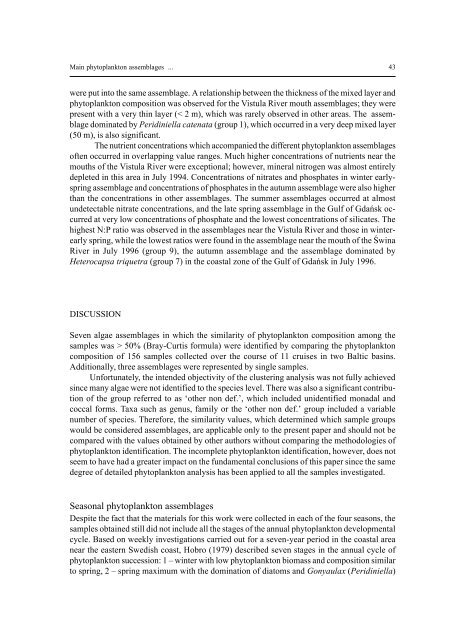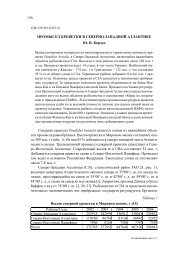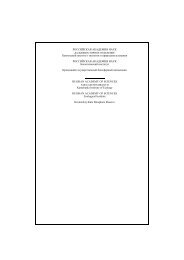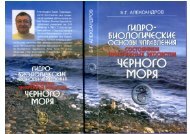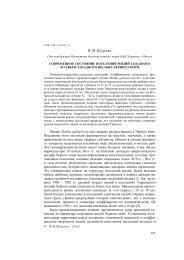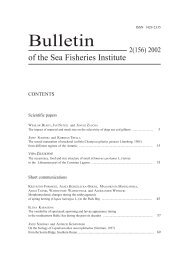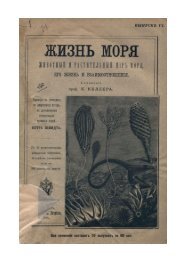Bulletin of the Sea Fisheries Institute 2 (153) 2001 - CEEMaR
Bulletin of the Sea Fisheries Institute 2 (153) 2001 - CEEMaR
Bulletin of the Sea Fisheries Institute 2 (153) 2001 - CEEMaR
Create successful ePaper yourself
Turn your PDF publications into a flip-book with our unique Google optimized e-Paper software.
Main phytoplankton assemblages ... 43<br />
were put into <strong>the</strong> same assemblage. A relationship between <strong>the</strong> thickness <strong>of</strong> <strong>the</strong> mixed layer and<br />
phytoplankton composition was observed for <strong>the</strong> Vistula River mouth assemblages; <strong>the</strong>y were<br />
present with a very thin layer (< 2 m), which was rarely observed in o<strong>the</strong>r areas. The assemblage<br />
dominated by Peridiniella catenata (group 1), which occurred in a very deep mixed layer<br />
(50 m), is also significant.<br />
The nutrient concentrations which accompanied <strong>the</strong> different phytoplankton assemblages<br />
<strong>of</strong>ten occurred in overlapping value ranges. Much higher concentrations <strong>of</strong> nutrients near <strong>the</strong><br />
mouths <strong>of</strong> <strong>the</strong> Vistula River were exceptional; however, mineral nitrogen was almost entirely<br />
depleted in this area in July 1994. Concentrations <strong>of</strong> nitrates and phosphates in winter earlyspring<br />
assemblage and concentrations <strong>of</strong> phosphates in <strong>the</strong> autumn assemblage were also higher<br />
than <strong>the</strong> concentrations in o<strong>the</strong>r assemblages. The summer assemblages occurred at almost<br />
undetectable nitrate concentrations, and <strong>the</strong> late spring assemblage in <strong>the</strong> Gulf <strong>of</strong> Gdañsk occurred<br />
at very low concentrations <strong>of</strong> phosphate and <strong>the</strong> lowest concentrations <strong>of</strong> silicates. The<br />
highest N:P ratio was observed in <strong>the</strong> assemblages near <strong>the</strong> Vistula River and those in winterearly<br />
spring, while <strong>the</strong> lowest ratios were found in <strong>the</strong> assemblage near <strong>the</strong> mouth <strong>of</strong> <strong>the</strong> Œwina<br />
River in July 1996 (group 9), <strong>the</strong> autumn assemblage and <strong>the</strong> assemblage dominated by<br />
Heterocapsa triquetra (group 7) in <strong>the</strong> coastal zone <strong>of</strong> <strong>the</strong> Gulf <strong>of</strong> Gdañsk in July 1996.<br />
DISCUSSION<br />
Seven algae assemblages in which <strong>the</strong> similarity <strong>of</strong> phytoplankton composition among <strong>the</strong><br />
samples was > 50% (Bray-Curtis formula) were identified by comparing <strong>the</strong> phytoplankton<br />
composition <strong>of</strong> 156 samples collected over <strong>the</strong> course <strong>of</strong> 11 cruises in two Baltic basins.<br />
Additionally, three assemblages were represented by single samples.<br />
Unfortunately, <strong>the</strong> intended objectivity <strong>of</strong> <strong>the</strong> clustering analysis was not fully achieved<br />
since many algae were not identified to <strong>the</strong> species level. There was also a significant contribution<br />
<strong>of</strong> <strong>the</strong> group referred to as ‘o<strong>the</strong>r non def.’, which included unidentified monadal and<br />
coccal forms. Taxa such as genus, family or <strong>the</strong> ‘o<strong>the</strong>r non def.’ group included a variable<br />
number <strong>of</strong> species. Therefore, <strong>the</strong> similarity values, which determined which sample groups<br />
would be considered assemblages, are applicable only to <strong>the</strong> present paper and should not be<br />
compared with <strong>the</strong> values obtained by o<strong>the</strong>r authors without comparing <strong>the</strong> methodologies <strong>of</strong><br />
phytoplankton identification. The incomplete phytoplankton identification, however, does not<br />
seem to have had a greater impact on <strong>the</strong> fundamental conclusions <strong>of</strong> this paper since <strong>the</strong> same<br />
degree <strong>of</strong> detailed phytoplankton analysis has been applied to all <strong>the</strong> samples investigated.<br />
<strong>Sea</strong>sonal phytoplankton assemblages<br />
Despite <strong>the</strong> fact that <strong>the</strong> materials for this work were collected in each <strong>of</strong> <strong>the</strong> four seasons, <strong>the</strong><br />
samples obtained still did not include all <strong>the</strong> stages <strong>of</strong> <strong>the</strong> annual phytoplankton developmental<br />
cycle. Based on weekly investigations carried out for a seven-year period in <strong>the</strong> coastal area<br />
near <strong>the</strong> eastern Swedish coast, Hobro (1979) described seven stages in <strong>the</strong> annual cycle <strong>of</strong><br />
phytoplankton succession: 1 – winter with low phytoplankton biomass and composition similar<br />
to spring, 2 – spring maximum with <strong>the</strong> domination <strong>of</strong> diatoms and Gonyaulax (Peridiniella)


